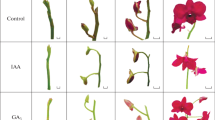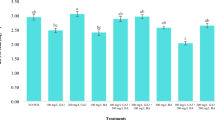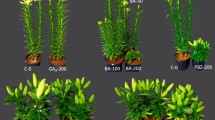Summary
In the short-day plant Pharbitis nil, strain “Violet”, flower formation is inhibited by application of the growth retardant N,N-dimethylaminosuccinamic acid (B 995) via the roots for a period of 24 hours prior to one inductive long night. Terminal flower bud formation is suppressed by a B 995 concentration of 100 mg/l, but for complete suppression of all axillary flower buds 2000 mg/l is required. Inhibition of flower formation is also caused by B 995 application via plumules or cotyledons, even if made at the end of the inductive night. B 995 treatment always results in short, thick internodes and dark-green leaves.
Transport of 14C-labeled B 995 from cotyledons to plumules and roots takes place during a 16-hour dark period. However, very little label moves from a treated to an untreated cotyledon. Application of B 995 to one of the two cotyledons results in flower inhibition, although the untreated cotyledon produces sufficient flower hormone to induce optimal flower formation. It is concluded therefore that in the short-day plant Pharbitis B 995 does not affect flower hormone production, but rather inhibits floral initiation by interfering with the action of the hormone in the shoot apex.
Inhibition of flower formation by B 995 can be completely overcome by application of gibbrellin A3 to the plumulus before the long nigh. A dose of 0.01 μg GA3/apex is sufficient to re-establish flowering, but much more GA3 is required to restore internode length equal to that of the control. Indole-3-acetic acid and naphthalene acetic acid are totally inactive in overcoming B 995 inhibition of flower formation and growth.
The growth rate of Pharbitis plants treated with B 995 and continuously grown in long-day conditions is initially low, but reaches the same level as in untreated plants approximately 25 days after treatment.
14C-labeled B 995 applied to cotyledons accumulates to a high degree in roots and in the basal part of the shoots. 14C-B 995 is metabolized very slowly and persists therefore in Pharbitis plants for prolonged periods of time.
Similar content being viewed by others
References
Baldev, B., and A. Lang: Control of flower formation by growth retardants and gibberellin in Samolus parviflorus, a long-day plant. Amer. J. Bot. 52, 408–417 (1965).
——, and A. O. Agatep: Gibberellin production in pea seeds developing in excised pods: Effect of growth retardant AMO-1618. Science 147, 155–157 (1965).
Bukovac, M. J.: Modification of the vegetative development of Phaseolus vulgaris with N,N-dimethylaminomaleamic acid. Amer. J. Bot. 51, 480–485 (1964).
Cathey, H. M.: Physiology of growth retarding chemicals. Ann. Rev. Plant Physiol. 15, 271–302 (1964).
Cleland, R.: Evidence on the site of action of growth retardants. Plant and Cell Physiol. 6, 7–15 (1965).
Dennis, D. T., C. D. Upper, and C. A. West: An enzymic site of inhibition of gibberellin biosynthesis by Amo 1618 and other plant growth retardants. Plant Physiol. 40, 948–952 (1965).
Martin, G. C., M. W. Williams, and L. P. Batjer: Movement and fate of labeled N-dimethyl amino succinamic Acid (B-nine), a size controlling compound, in apple seedlings. Proc. Amer. Soc. Hort. Sci. 84, 7–13 (1964).
Murashige, T.: Effects of stem-elongation retardants and gibberellin on callus growth and organ formation in tobacco tissue culture. Physiol. Plantarum (Kbh.) 18, 665–673 (1965).
Ninnemann, H., J. A. D. Zeevaart, H. Kende, and A. Lang: The plant growth retardant CCC as inhibitor of gibberellin biosynthesis in Fusarium moniliforme. Planta (Berl.) 61, 229–235 (1964).
Palec, L., H. Kende, H. Ninnemann, and A. Lang: Physiological effects of gibberellic acid. VIII. Growth retardants on barley endosperm. Plant Physiol. 40, 165–169 (1965).
Reed, D. J., T. C. Moore, and J. D. Anderson: Plant growth retardant B-995: A possible mode of action. Science 148, 1469–1471 (1965).
Riddell, J. A., H. A. Hageman, C. M. J'Anthony, and W. L. Hubbard: Retardation of plant growth by a new group of chemicals. Science 136, 391 (1962).
Sachs, R. M., and A. M. Kofranek: Comparative cytohistological studies on inhibition and promotion of stem growth in Chrysanthemum morifolium. Amer. J. Bot. 50, 772–779 (1963).
Zeevaart, J. A. D.: Effects of the growth retardant CCC on floral initiation and growth in Pharbitis nil. Plant Physiol. 39, 402–408 (1964).
—: Reduction of the gibberellin content of Pharbitis seeds by CCC and after-effects in the progeny. Plant Physiol. 41, 856–862 (1966).
—, and A. Lang: Suppression of floral induction in Bryophyllum daigremontianum by a growth retardant. Planta (Berl.) 59, 509–517 (1963).
Author information
Authors and Affiliations
Rights and permissions
About this article
Cite this article
Zeevaart, J.A.D. Inhibition of stem growth and flower formation in Pharbitis nil with N, N-dimethylaminosuccinamic acid (B 995). Planta 71, 68–80 (1966). https://doi.org/10.1007/BF00384643
Received:
Issue Date:
DOI: https://doi.org/10.1007/BF00384643




